Radishes are one of the easiest crops to grow. The radish is a cool-weather crop. Harvest radishes in spring or fall for the best flavor and texture. Radish is ready to eat as few as three weeks after sowing seeds. It is easy to understand why radishes are a favorite of home gardeners.
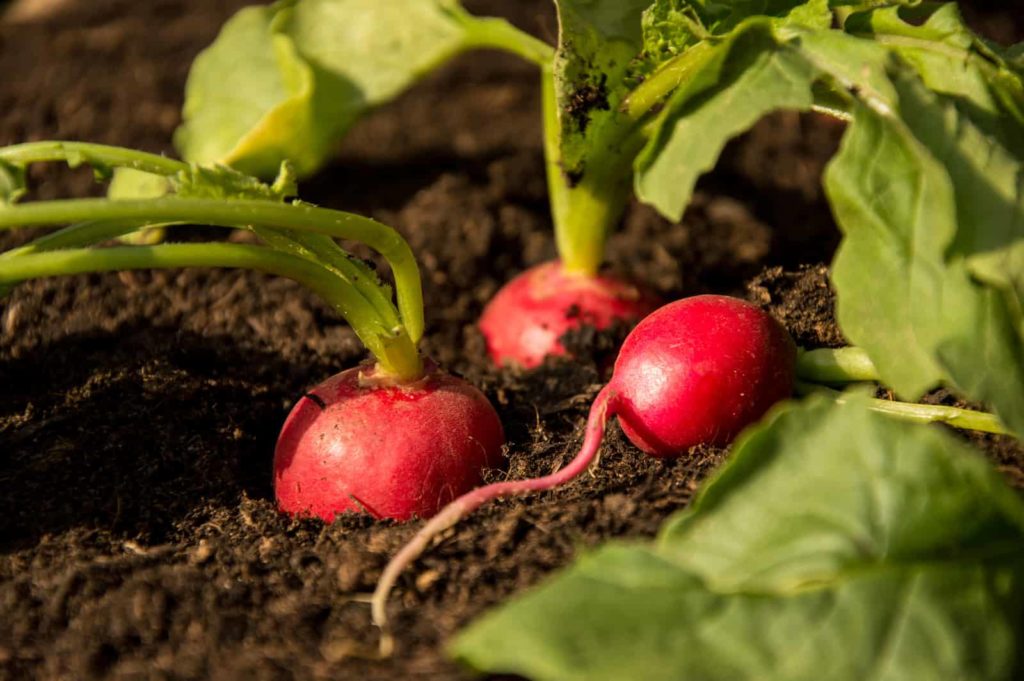
Spring radishes such as ‘French Breakfast’, ‘Snow Belle’, and ‘Plum Purple’ are quick-growing, crisp, and colorful. They are typically eaten raw. White, carrot-shaped daikon (Japanese) radishes such as ‘April Cross’ and ‘Summer Cross Hybrid’ are typically steamed, stir-fried, or grated into a condiment. These longer-to-harvest, winter-grown roots flavor many Asian dishes.
Good Products at Amazon for Raised Bed Growing
- Galvanized Raised Bed 8×3
- Cedar Raised Bed 4×8
- Elevated Cedar Planter 4×2
- Walk-In Greenhouse Tunnel 15x7x7
- Row Cover for Freeze Protection 10×30
Where to plant radishes
- Grow radishes in full sun or partial shade.
- Plant radishes in loose, humusy (but not nitrogen-rich) well-drained soil.
- Remove soil lumps, rocks, and roots from radish planting beds. Obstructions can cause roots to grow malformed.
- Add wood ashes to the soil to ward off root maggots.
- Add organic matter to planting beds before sowing radishes.
- Radishes prefer a soil pH of 5.5 to 6.8.
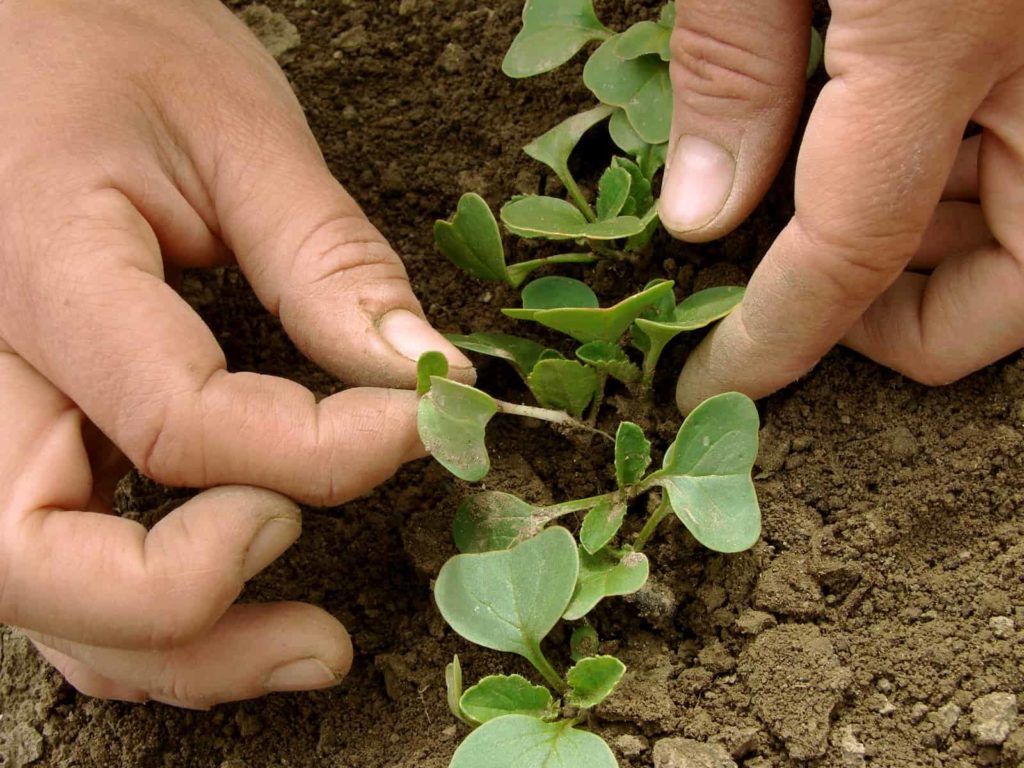
Radishes quick growing tips
- Sow radishes in the garden 2 to 3 weeks before the average date of the last frost in spring.
- Radish succession planting can happen every 2 weeks from early spring until late spring and in late summer and autumn.
- Radishes require 22 to 70 days to come to harvest.
- Complete the harvest before the weather grows warm.
- In mild winter regions, grow radish plants in late autumn and early winter.
- Radish yield: Plant 15 radishes per household member each month.
Radish planting time
- Radishes are a cool-weather crop.
- Sow radishes in the garden 2 to 3 weeks before the average date of the last frost in spring.
- Radishes can be planted as soon as the soil thaws in spring.
- Sow succession crops every 2 to 4 weeks in spring and in autumn, or plant a combination of short and long-to-maturity varieties.
- Two or more crops can be grown in spring.
- Radishes require 22 to 70 days to come to harvest. Complete the harvest before the weather grows warm. Warm weather can result in small roots.
- White “winter” radishes must be planted so that they come to maturity in cool weather. Plant white radishes about 8 weeks before the average date of the first fall frost.
- Some radish varieties will not form roots in the summer heat.
- Radish roots don’t grow well in summer heat; plant late spring radishes in a shady spot; keep the soil cool with mulch.
- Long days may also cause radishes to flower; plant radishes during the shorter days of spring and autumn. In mild winter regions, grow radishes in late autumn and early winter.
- Radishes can withstand frost.
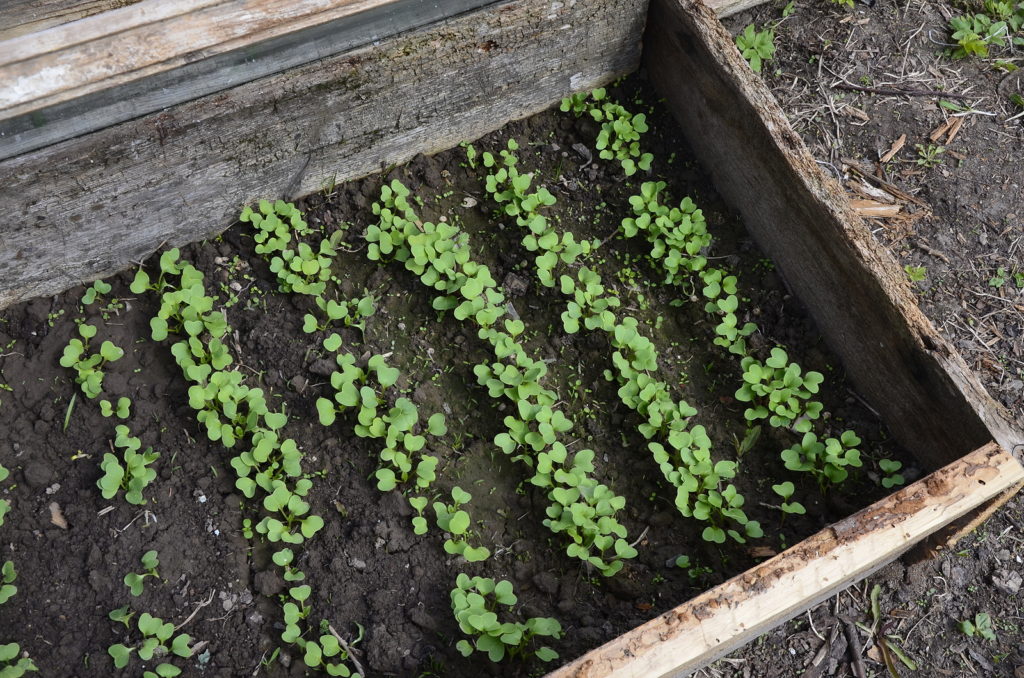
Planting and spacing radishes
- Sow radish seed ½ inch (12mm) deep and 1 inch (2.5cm) apart; thin successful seedlings from 2 to 4 inches (2.5-10cm) apart in wide rows depending upon the variety.
- Plant winter radishes 3 to 4 inches apart.
- Radish seeds are so small that they certainly require thinning once seedlings appear.
- Radish germination happens in 3 to 6 days; seedlings can be thinned to proper spacing once they have appeared. Use a garden scissor to cut green tops off at the soil level.
- Allow greater room for winter varieties.
- Space single rows or mounded ridges 10 to 16 inches (25-40cm) apart.
Radish companion plants
- Plant radishes with cucumbers, lettuce, nasturtiums, peas, and peppers.
- Radishes can be planted as an under-crop beneath nearly all cool-season vegetables.
- Plant radishes with other root vegetables.
Container growing radishes
- Radishes can be grown in containers. Plant radishes in round containers in concentric circles.
- Sow radishes in containers at least 6 inches (14cm) deep.
- Plant 12 or more radishes in an 8-inch container
- Move containers to cool locations if the weather grows warm.
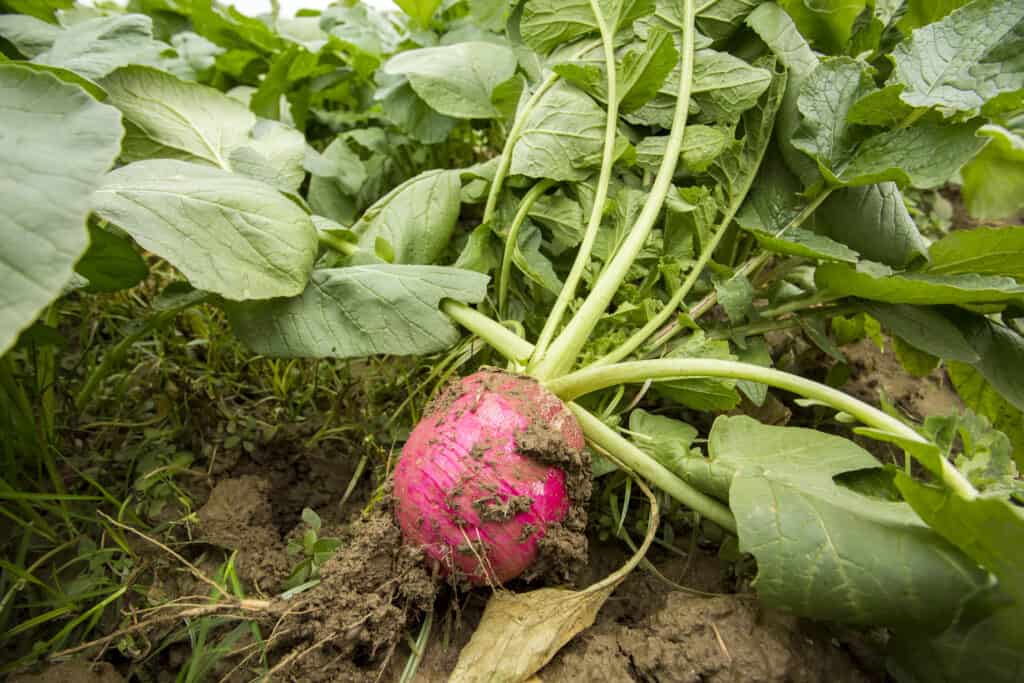
Watering and feeding radishes
- Keep radish planting beds moist but not wet. Even, regular watering will result in quick growth.
- Radishes that receive too little water will become hot tasting and have a woody texture.
- If watering is difficult, grow radishes in a shady spot where the soil does not dry out quickly.
- Prepare planting beds with aged compost.
- Side dress radishes with aged compost at midseason.
Radish care
- Radishes will bolt or go to seed if grown during the long days of summer. Cover plants in midsummer so that they get 8 rather than 12 hours of sunlight; 12-hour days produce flowers and seeds but no roots
- Keep radishes evenly watered so that they grow quickly. Slow growth will cause radishes to taste hot.
Radish pests and diseases
- Radishes can be attacked by aphids, flea beetles, and root maggots. Pinch out infested foliage.
- Usually, radishes grow so quickly that pests are not a problem.
- Pinch out aphid-infested foliage and work wood ash or diatomaceous earth into the soil to control root maggots.
- A row cover will keep young seedlings safe from birds.
- Radishes have no serious disease problems.

How to Harvest radish
- Spring radishes require 20 to 30 days to reach harvest. Radish microgreens can be clipped in as few as 5 to 7 days. Roots can be harvested as soon as they reach usable size.
- Winter radishes require 50 to 60 days to reach harvest.
- Red radishes are ready for harvest when roots reach 1 inch across. Take larger, fatter radishes first and let smaller ones grow on to size.
- Lift the whole plant when the radishes are the right size. Lift a few or push the soil aside gently to decide if they are large enough to harvest.
- Do not leave radishes in the ground too long or they will become pithy.
Storing and preserving radishes
- Red radishes are best used young and tender; if left too long they will become soft and pithy.
- Red radishes store best in the refrigerator for 3 to 4 weeks
- White winter and daikon radishes will keep in the refrigerator for 3 weeks.
- Winter radishes can be stored between layers of moist sand in a box or tub.
- Freezing radishes: wash, peel, stir-fry briefly, package, and freeze. Use these in stews, soups, and stir-fries.
- Drying radishes: wash, trim off the top, slice 1/8 inch thick; spread over a drying tray and dry until brittle. Use dry radishes scattered over a salad or add boiling water and simmer until tender then serve.
- Canning radishes: radishes can be canned like carrots.

Good Products at Amazon For Growing Radishes:
- Neem Bliss 100% Cold Pressed Neem Oil
- Monterey BT Caterpillar Killer
- Safer Brand Insect Killing Soap
- PyGanic Botanical Insecticide
- Captain Jack’s Dead Bug Brew
- Live Ladybugs
- Natures Good Guys Beneficial Nematodes
- Yellow Sticky Traps
- Southern Ag Liquid Copper Fungicide
- MycoStop Biofungicide
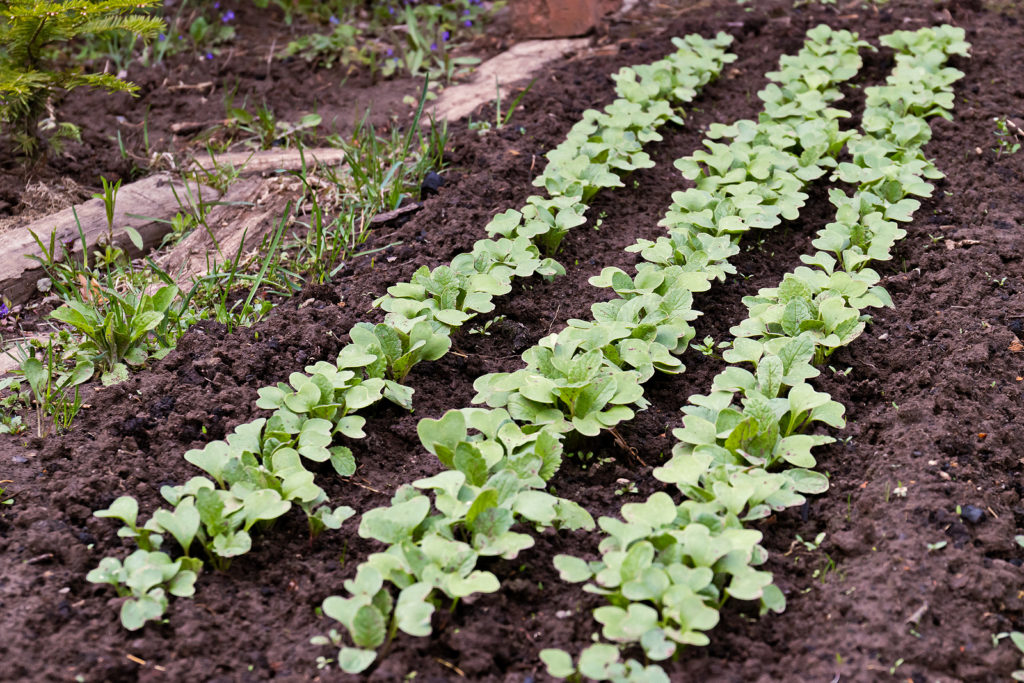
Here’s your complete guide to growing radishes!
Different Types of radishes
Raphanus sativus is the basic radish but there are many different varieties with maturing dates ranging from 20 to 60 days.
Red radishes
- Red radishes are also called “cherry” radishes or garden radishes; these have red skin, white flesh, and green leaves, and are about cherry-sized. Some have a mild flavor; some have a spicy flavor. These are the most common spring types of radishes grown.
- Red radishes are easy to grow and fast-growing to maturity. They are a good choice for both garden and container growing.
- These radishes can be sliced in salads or eaten raw. They can be boiled or added to soups. They can be roasted with meat or sauteed with other vegetables.
- There are also long, red varieties.
White or winter radishes
- White radishes are close relatives of red radishes; they are larger, milder in flavor, and longer to maturity.
- ‘Icicle’ is a commonly grown white radish; it grows to 4 inches long and is the quickest to mature of the white radishes.
- Many of the white radishes are known as “winter radishes” because they are often planted in mid or late summer, harvested in fall, and stored during winter in damp same
- Winter radishes taste better cooked.
- One of the best-known winter radishes is daikon.
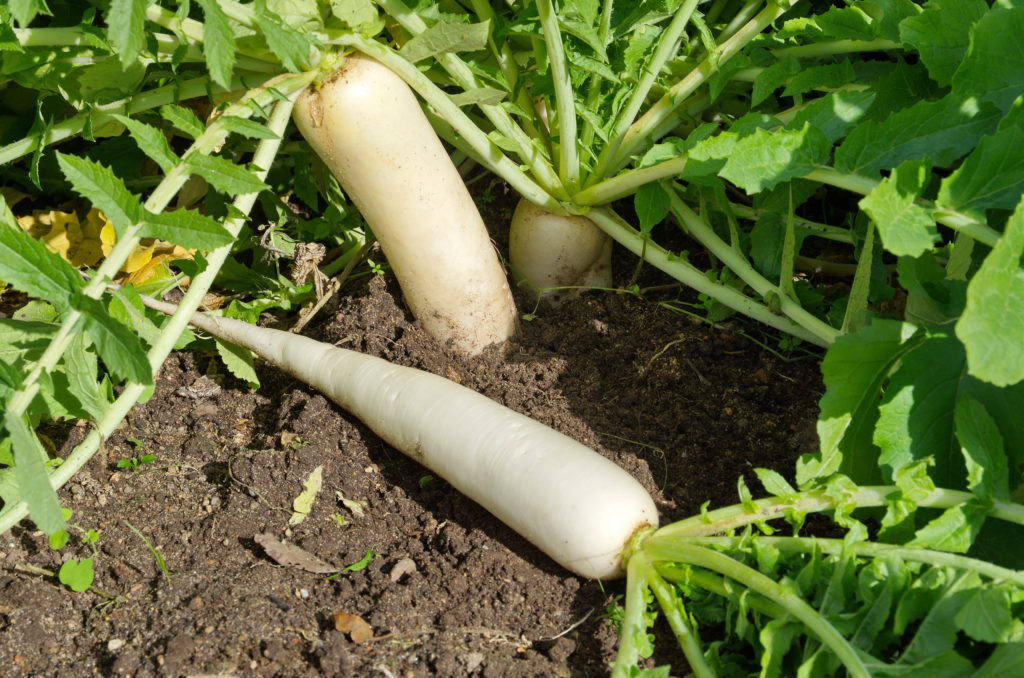
Daikon
- Daikon is a white, Asian radish variety (Raphanus sativus longi pinnatus).
- Daikon has a peppery flavor; it is milder than red radishes.
- Daikon contains disease, a starch-digesting enzyme; this radish goes well with a heavy-starch meal.
- Daikon is the most popular Japanese vegetable.
- Daikon is often served grated or slivered with raw fish on rice (sushi) and with rice in general.
- Daikon can be used sliced raw in a green salad, stir-fried, or cooked in soup.
Sakurajima
- Sakurajima is a very large radish; single roots grow from 10 to 50 pounds in size.
- Sow Sakurjima seeds 24 inches apart; the plant grows to the size of a bush tomato.
- Sakurajima grows to maturity in about 70 days.
- Sakurajima is very hot and is not eaten raw; cook this root like a turnip.
Lobak
- Lobak is a Korean radish. The root is white with some pale green shading at the base. The root is as wide as a potato and 6 to 8 inches long.
- Lobak is more spicy than mild. It can be cut into strings and served with a dip.
- Use Lobak to make the Korean relish called kim chee (kimchee).
- Lobak can be added to omelets. It can be sauteed as a side dish with carrots and onions, or cooked in a soup.
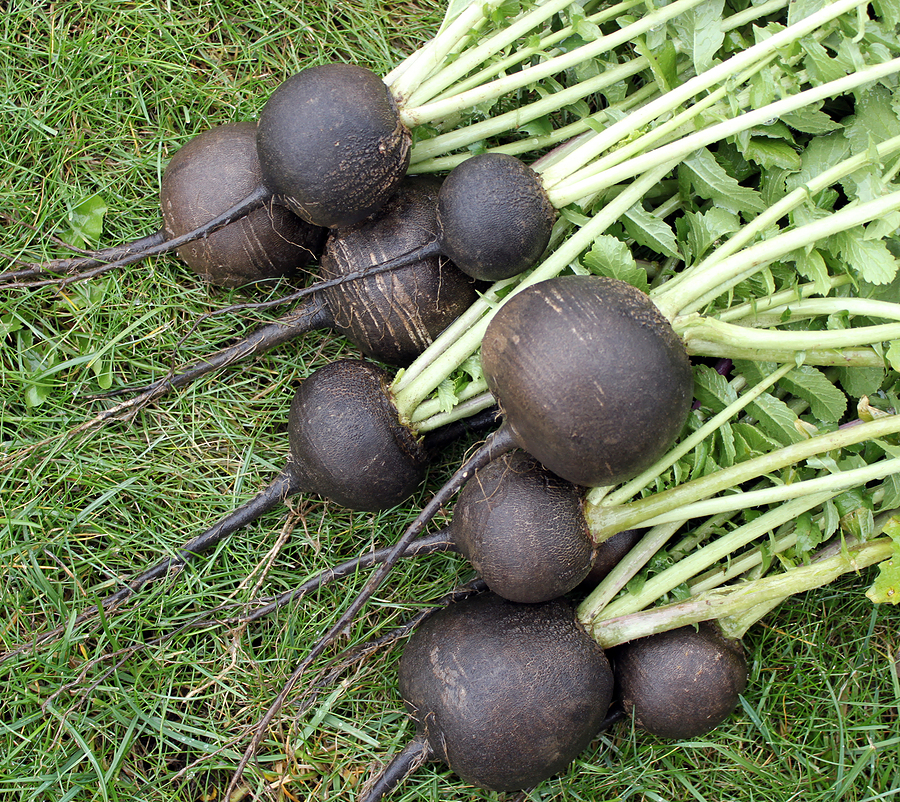
Black radishes
- There are two types of black radish: Black Spanish radish and Chinese black radish.
- Black radishes resemble daikon; they grow 7 to 8 inches long and 2 to 3 inches in diameter; some are turnip shaped
- Black radishes are winter radishes; plant them in winter.
- Cook black radishes like turnips.
Rat-tail radishes
- Rat-tail radishes are grown for their long bean-like seed pods which can mature at 9 inches long.
- Rat-tail radish seed pods are wide at one end and dwindle to a tip at the other end.
- Use rat-tail radish seed pods like edible-podded peas or stir-fry or pickle them. The taste is moderately hot.
- Harvest rat-tail radishes a few weeks after sowing.
Radishes in the kitchen
- Radishes can be served raw in appetizers, salads, sandwiches, or with dip.
- Cooked radishes can be added to soups, stews, omelets, an stir-fries.
- Radishe green can be prepared like spinach when they are fresh and tender.
- Serve radishes plain or dipped in salt or mayonnaise.
- Radishes are good grated or sliced thin in a tossed salad.
- Add sliced radish to a cucumber or tomato sandwich or salad.
- Winter radish can be cut into long strips; dip each strip into a beaten egg, then into crumbs and then fry it.
- You can sprout radish seeds. Use radish sprouts and microgreens on salads and sandwiches.
Saving radish seeds
- Radishes are bee-pollinated and self-incompatible. Bees carry pollen from radish to radish. Cultivars may cross between varieties blooming within 1/4 mile.
- Allow one cultivar to flower at a time to avoid cross-pollination.
- Red radishes are annuals. Winter radishes are biennials
- Radishes left in the ground past their maturity date will send up a stalk, flower, and form seed pods.
- Let seed pods develop, ripened, and dry on the stalk.
- Harvest seed pods by breaking off the stalks. Open the pods when the seed rattle inside.
- Let seeds continue drying in a paper envelope. Store seeds in a dry place/
- Radish seeds are viable for about 4 to 5 years.
Radish frequently asked questions
Q: Why do some spring radishes develop lots of leaves but only develop skinny roots?
A: Spring radishes will only produce large roots in cool weather. Warm weather or overcrowding will result in small skinny roots.
Q: Why do some spring radishes flower and produce small roots?
A: Long sunny days will force spring radishes to flower. Plant radishes when the days are short in early spring or in fall.
Q: Why do radishes crack or split or get pithy?
A: These radishes are old; harvest radishes at the suggested days to maturity listed on the seed packet.
Q: What makes radishes taste hot?
A: Slow growth and inadequate water result in radishes tasting hot.
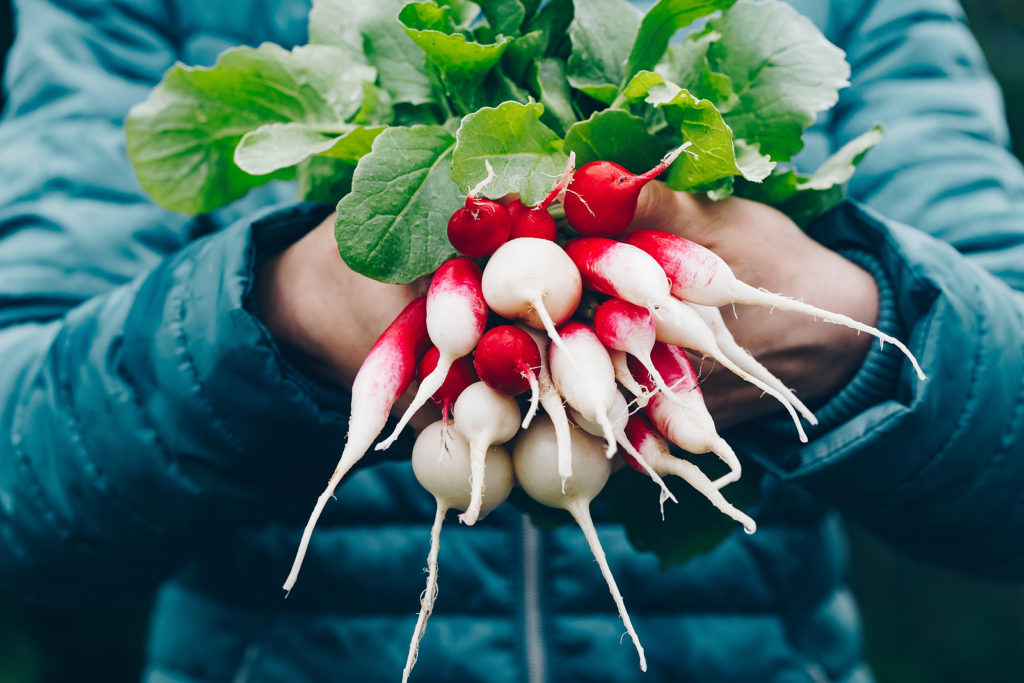
Radish varieties to grow
- Radishes can be grown for spring or winter crops. Spring varieties are the common small red varieties. Winter radishes are larger, oblong, and can grow 8 to 9 inches long.
- Spring crop: ‘Cherry Belle’ (22 days); ‘Burpee White’ (25 days).
- Winter crop: ‘Black Spanish’ (55 days); ‘White Chinese’ (60 days).
Selected radish varieties
Long-rooted
- ‘White Icicle’ has a root 6 inches long and 1 inch wide; matures in 27 days.
Round to oval rooted
- ‘Cherry Belle’ has round bright red roots, 3 to 4 inches wide; All-America Selection; matures in 22 days.
- ‘Easter Egg’ has oval multicolored roots, red to purple, 1.5 inches wide; matures in 25 days.
- ‘French Breakfast’ is an oblong root with a red top and white bottom, about 1.5 inches wide; matures in 23 days.
Winter types
- ‘China Rose’ has a deep red rose root with white flesh, 6 to 7 inches long and 2.5 inches wide; matures in 52 days.
- ‘Round Black Spanish’ has a round black root with white flesh; matures in 55 days.
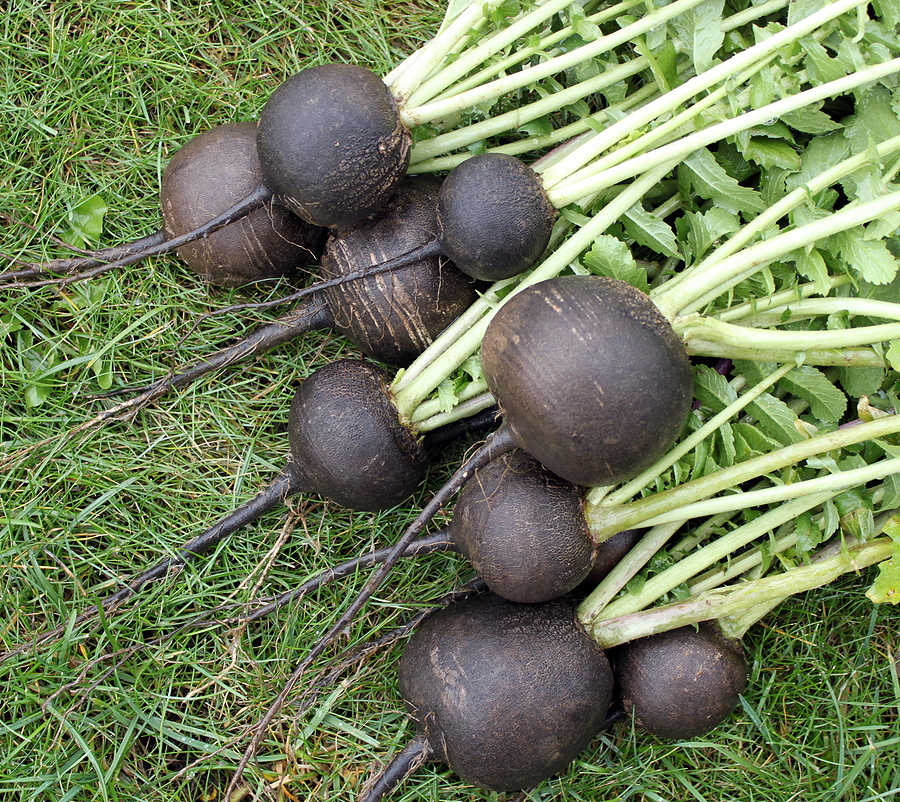
Black Spanish radish
The Black Spanish Radish will add a zingy addition to a fresh garden salad.
Some radishes—such as the French breakfast radish—can be mild and almost sweet. Others have a peppery flavor that will zip up your palate right into your nostrils. The black Spanish radish is one of them.
The black Spanish radish is a winter-keeping radish meaning if you set it aside under the right conditions it will keep for use at the table long after your local radish harvest season has passed.
Growing black radishes. Radishes are cool-season crops best planted in the spring and fall. While a French breakfast radish—the rosy scarlet radish with the white tip—comes to maturity in less than 25 days after planting, the black Spanish radish takes twice to three times as long to reach maturity. That means the black Spanish radishes planted back in September are now coming to harvest. (If you live in colder regions, black Spanish radishes are already in winter storage.)
Types of black radish. There are actually two types of black Spanish radish—the round one which is about the size and shape of a turnip and the long black Spanish radish which is cylindrical and can grow to about 8 inches (20 cm) long. Both are black-skinned and have flesh that is crisp and white and quite peppery. The long variety will be more pungent than the round, blunt-ended one.
Choosing. When choosing a black Spanish radish, look for one that is solid, heavy, free of cracks, and generally unblemished. Always avoid radishes that give in to pressure when squeezed. Those radishes will likely be pithy.
Storing. The key to keeping the black Spanish radish for use throughout the winter is how it is stored. The old-fashioned way is to submerge these roots in a box or carton of moist sand in a cool place that will not freeze. The modern, easy way is to simply keep the black Spanish radish very dry and store it in a perforated bag in the refrigerator.
Serving. Here is a recipe for a black Spanish radish salad: Shred the root and marinate it in salted water for two hours. (This will take the edge off its pungency.) Drain and press the shredded root dry. Serve as a salad with vinegar and oil. Sprinkle fresh minced herbs over the top.
Radish articles on Harvest to Table:
How to Plant, Grow, and Harvest Radishes
Radish Growing Problems Troubleshooting
Tasty Ways to Cook and Serve Radishes
Radish Root and Leafy Green Salad
How to Make Savory Radish-Cabbage Coleslaw
About radishes
- Common name. Radish
- Botanical name. Raphanus sativus (spring radish); Raphanus sativus longipinnatus (winter radish)
- Origin. Temperate regions of Asia
More tips:
Garden Planning Books at Amazon:
- Vegetable Garden Grower’s Guide
- Tomato Grower’s Answer Book
- Vegetable Garden Almanac & Planner
- Kitchen Garden Grower’s Guide Vegetable Encyclopedia
Grow 80 vegetables: KITCHEN GARDEN GROWERS’ GUIDE
More how to grow articles:
Learn how to plant, grow, and harvest your favorite vegetables. Click below for all you need to know.
- Artichoke
- Arugula
- Asparagus
- Beans, Snap
- Beets
- Broad Beans
- Broccoli
- Brussels Sprouts
- Cabbage
- Cantaloupe — Melons
- Cardoon
- Carrots
- Cauliflower
- Celeriac
- Celery
- Chard
- Chayote Squash
- Chickpeas
- Chicory
- Chinese Cabbage
- Collards
- Corn Salad
- Corn, Sweet
- Cresses
- Cucumbers
- Eggplant
- Endive and Escarole
- Fava Beans
- Florence Fennel
- Garbanzo Beans
- Garlic
- Horseradish
- Jerusalem Artichoke
- Kale
- Kohlrabi
- Leeks
- Lettuce
- Lima Beans
- Melons
- Mizuna
- Mustard Greens
- New Zealand Spinach
- Okra
- Onions
- Parsnips
- Peanuts
- Peas
- Peppers
- Potatoes
- Pumpkins
- Radicchio
- Radishes
- Rhubarb
- Rutabaga
- Salsify
- Shallots
- Sorrel
- Southern Peas
- Soybeans
- Spinach
- Squash, Summer
- Squash, Winter
- Sunchokes
- Sweet Potato
- Swiss Chard
- Taro
- Tomatillo
- Tomatoes
- Turnips
- Watermelon
- Zucchini















